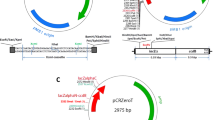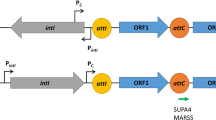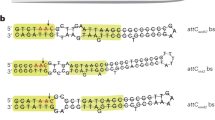Abstract
We have assembled two BAC vectors containing a single fragment spanning the entire CFTR locus and including the upstream and downstream regions. The two vectors differ in size of the upstream region, and were recovered in Escherichia coli, with intact BAC DNAs prepared for structural and functional analyses. Sequence analysis allowed precise mapping of the inserts. We show that the CFTR gene was wild type and is categorized as the most frequent haplotype in Caucasian populations, identified by the following polymorphisms: (GATT)7 in intron 6a; (TG)11T7 in intron 8; V470 at position 470. CFTR expression and activity were analyzed in model cells by RT-PCR, quantitative real-time PCR, western blotting, indirect immunofluorescence and electrophysiological methods, which show the presence of an active CFTR Cl − channel. Finally, and supporting the hypothesis that CFTR functions as a receptor for Pseudomonas aeruginosa, we show that CFTR-expressing cells internalized more bacteria than parental cells that do not express CFTR. Overall, these data demonstrate that the BAC vectors contain a functional CFTR fragment and have unique features, including derivation from a single fragment, availability of a detailed genomic map and the possibility to use standard extraction procedures for BAC DNA preparations.
This is a preview of subscription content, access via your institution
Access options
Subscribe to this journal
Receive 12 print issues and online access
$259.00 per year
only $21.58 per issue
Buy this article
- Purchase on Springer Link
- Instant access to full article PDF
Prices may be subject to local taxes which are calculated during checkout









Similar content being viewed by others
References
Stutts MJ, Canessa CM, Olsen JC, Hamrick M, Cohn JA, Rossier BC et al. CFTR as a cAMP-dependent regulator of sodium channels. Science 1995; 269: 847–850.
Matsui H, Grubb BR, Tarran R, Randell SH, Gatzy JT, Davis CW et al. Evidence for periciliary liquid layer depletion, not abnormal ion composition, in the pathogenesis of cystic fibrosis airways disease. Cell 1998; 95: 1005–1015.
Worlitzsch D, Tarran R, Ulrich M, Schwab U, Cekici A, Meyer KC et al. Effects of reduced mucus oxygen concentration in airway Pseudomonas infections of cystic fibrosis patients. J Clin Invest 2002; 109: 317–325.
Dodge JA, Lewis PA, Stanton M, Wilsher J . Cystic fibrosis mortality and survival in the UK: 1947–2003. Eur Resp J 2007; 29: 522–526.
Ratjen F . Recent advances in cystic fibrosis. Paediatr Respir Rev 2008; 9: 144–148.
Griesenbach U, Alton EW . UK cystic fibrosis gene therapy consortium gene transfer to the lung: lessons learned from more than 2 decades of CF gene therapy. Adv Drug Deliv Rev 2009; 61: 128–139.
Johnson LG, Olsen JC, Sarkadi B, Moore KL, Swanstrom R, Boucher RC . Efficiency of gene transfer for restoration of normal airway epithelial function in cystic fibrosis. Nat Genet 1992; 2: 21–25.
Farmen SL, Karp PH, Ng P, Palmer DJ, Koehler DR, Hu J et al. Gene transfer of CFTR to airway epithelia: low levels of expression are sufficient to correct Cl-transport and overexpression can generate basolateral CFTR. Am J Physiol Lung Cell Mol Physiol 2005; 289: L1123–L1130.
Conese M, Boyd AC, Di Gioia S, Auriche C, Ascenzioni F . Genomic context vectors and artificial chromosomes for cystic fibrosis gene therapy. Curr Gene Ther 2007; 7: 175–187.
Crawford I, Maloney PC, Zeitlin PL, Guggino WB, Hyde SC, Turley H et al. Immunocytochemical localization of the cystic fibrosis gene product CFTR. Proc Natl Acad Sci USA 1991; 88: 9262–9266.
Trezise AE, Buchwald M . In-vivo cell-specific expression of the cystic fibrosis transmembrane conductance regulator. Nature 1991; 353: 434–437.
Engelhardt JF, Yankaskas JR, Ernst SA, Yang Y, Marino CR, Boucher RC et al. Submucosal glands are the predominant site of CFTR expression in the human bronchus. Nat Genet 1992; 2: 240–247.
Trezise AE, Romano PR, Gill DR, Hyde SC, Sepúlveda FV, Buchwald M et al. The multidrug resistance and cystic fibrosis genes have complementary patterns of epithelial expression. EMBO J 1992; 11: 4291–4303.
Quinton PM . Cystic fibrosis: lessons from the sweat gland. Physiology (Bethesda) 2007; 22: 212–225.
Smith DJ, Nuthall HN, Majetti ME, Harris A . Multiple potential intragenic regulatory elements in the CFTR gene. Genomics 2000; 15: 90–96.
Anand R, Ogilvie DJ, Butler R, Riley JH, Finniear RS, Powell SJ et al. A yeast artificial chromosome contig. encompassing the cystic fibrosis locus. Genomics 1991; 9: 124–130.
Manson AL, Trezise AE, MacVinish LJ, Kasschau KD, Birchall N, Episkopou V et al. Complementation of null CF mice with a human CFTR YAC transgene. EMBO J 1997; 16: 4238–4249.
Chou JL, Rozmahel R, Tsui LC . Characterization of the promoter region of the cystic fibrosis transmembrane conductance regulator gene. J Biol Chem 1991; 266: 24471–24476.
Vuillaumier S, Dixmeras I, Messaï H, Lapouméroulie C, Lallemand D, Gekas J et al. Cross-species characterization of the promoter region of the cystic fibrosis transmembrane conductance regulator gene reveals multiple levels of regulation. Biochem J 1997; 327: 651–662.
Yoshimura K, Nakamura H, Trapnell BC, Dalemans W, Pavirani A, Lecocq JP et al. The cystic fibrosis gene has a ‘housekeeping’-type promoter and is expressed at low levels in cells of epithelial origin. J Biol Chem 1991; 266: 9140–9144.
Smith AN, Wardle CJC, Harris A . Characterization of DnaseI hypersensitive sites in the 120 kb 5′ to the CFTR gene. Biochem Biophys Res Commun 1995; 211: 274–281.
Smith AN, Barth ML, McDowell TL, Moulin DS, Nuthall HN, Hollingsworth MA et al. A regulatory element in intron 1 of the cystic fibrosis transmembrane conductance regulator gene. J Biol Chem 1996; 271: 9947–9954.
Blackledge NP, Ott CJ, Gillen AE, Harris A . An insulator element 3′ to the CFTR gene binds CTCF and reveals an active chromatin hub in primary cells. Nucleic Acids Res 2009; 37: 1086–1094.
Campodónico VL, Gadjeva M, Paradis-Bleau C, Uluer A, Pier GB . Airway epithelial control of Pseudomonas aeruginosa infection in cystic fibrosis. Trends Mol Med 2008; 14: 120–133.
Pier GB, Grout M, Zaidi TS, Olsen JC, Johnson LG, Yankaskas JR et al. Role of mutant CFTR in hypersusceptibility of cystic fibrosis patients to lung infections. Science 1996; 271: 64–67.
Pier GB, Grout M, Zaidi TS . Cystic fibrosis transmembrane conductance regulator is an epithelial cell receptor for clearance of Pseudomonas aeruginosa from the lung. Proc Natl Acad Sci USA 1997; 94: 12088–12093.
Cocchia M, Kouprina N, Kim SJ, Larionov V, Schlessinger D, Nagaraja R . Recovery and potential utility of YACs as circular YACs/BACs. Nucleic Acids Res 2000; 28: E81.
Wang M, Lai E . Pulsed field separation of large supercoiled and open-circular DNAs and its application to bacterial artificial chromosome cloning. Electrophoresis 1995; 16: 1–7.
Sermet-Gaudelus I, Vallée B, Urbin I, Torossi T, Marianovski R, Fajac A et al. Normal function of the cystic fibrosis conductance regulator protein can be associated with homozygous (Delta)F508 mutation. Pediatr Res 2002; 52: 628–635.
Zegarra-Moran O, Monteverde M, Galietta LJ, Moran O . Functional analysis of mutations in the putative binding site for cystic fibrosis transmembrane conductance regulator potentiators. Interaction between activation and inhibition. J Biol Chem 2007; 282: 9098–9104.
Caci E, Caputo A, Hinzpeter A, Arous N, Fanen P, Sonawane N et al. Evidence for direct CFTR inhibition by CFTR(inh)-172 based on Arg347 mutagenesis. Biochem J 2008; 413: 135–142.
Magin-Lachmann C, Kotzamanis G, D’Aiuto L, Wagner E, Huxley C . Retrofitting BACs with G418 resistance, luciferase, and oriP and EBNA-1—new vectors for in-vitro and in-vivo delivery. BMC Biotechnol 2003; 3: 2.
Kotzamanis G, Abdulrazzak H, Gifford-Garner J, Haussecker PL, Cheung W, Grillot-Courvalin C et al. CFTR expression from a BAC carrying the complete human gene and associated regulatory elements. J Cell Mol Med 2009; 13: 2938–2948.
Schindelhauer D, Cooke HJ . Efficient combination of large DNA in vitro: in-gel site-specific recombination (IGSSR) of PAC fragments containing alpha satellite DNA and the human HPRT gene locus. Nucleic Acids Res 1997; 25: 2241–2243.
Laner A, Goussard S, Ramalho AS, Schwarz T, Amaral MD, Courvalin P et al. Bacterial transfer of large functional genomic DNA into human cells. Gene Therapy 2005; 12: 1559–1572.
Illek B, Maurisse R, Wahler L, Kunzelmann K, Fisher H, Gruenert DC . Cl transport in complemented CF bronchial epithelial cells correlates with CFTR mRNA expression level. Cell Physiol Biochem 2008; 22: 57–68.
Galietta LJV, Pagesy P, Folli C, Caci E, Romio L, Costes B et al. IL-4 is a potent modulator of ion transport in the human bronchial epithelium in vitro. J Immunol 2002; 168: 839–845.
Haggie PM, Verkman AS . Unimpaired lysosomal acidification in respiratory epithelial cells in cystic fibrosis. J Biol Chem 2009; 284: 7681–7686.
Schroeder TH, Lee MM, Yacono PW, Cannon CL, Gerçeker AA, Golan DE et al. CFTR is a pattern recognition molecule that extracts Pseudomonas aeruginosa LPS from the outer membrane into epithelial cells and activates NF-kappa B translocation. Proc Natl Acad Sci USA 2002; 99: 6907–6912.
Paillard F . Promoter attenuation in gene therapy: causes and remedies. Hum Gene Ther 1997; 8: 2009–2010.
Wade-Martins R, Saeki Y, Chiocca EA . Infectious delivery of a 135-kb LDLR genomic locus leads to regulated complementation of low-density lipoprotein receptor deficiency in human cells. Mol Ther 2003; 7: 604–612.
Zhang Y, Buchholz F, Muyrers JPP, Stewart AF . A new logic for DNA engineering using recombination in Escherichia coli. Nat Genet 1998; 20: 123–128.
Güldener U, Heinisch J, Köhler GJ, Voss D, Hegemann JH . A second set of loxP marker cassettes for Cre-mediated multiple gene knockouts in budding yeast. Nucleic Acids Res 2002; 30: E23.
Sambrook J, Russel D . A Laboratory Manual, 3rd edn. Cold Spring Harbor Laboratory Press, CSH: New York, 2001.
Biffi A, Sersale G, Cassetti A, Villa A, Bordignon C, Assael BM et al. Restoration of bacterial killing activity of human respiratory cystic fibrosis cells through cationic vector-mediated cystic fibrosis transmembrane conductance regulator gene transfer. Hum Gene Ther 1999; 10: 1923–1930.
Zielenski J, Rozmahel R, Bozon D, Kerem B, Grzelczak Z, Riordan JR et al. Genomic DNA sequence of the cystic fibrosis transmembrane conductance regulator (CFTR) gene. Genomics 1991; 10: 214–228.
Lucarelli M, Narzi L, Piergentili R, Ferraguti G, Grandoni F, Quattrucci S et al. A 96-well formatted method for exon and exon/intron boundary full sequencing of the CFTR gene. Anal Biochem 2006; 353: 226–235.
Lucarelli M, Grandoni F, Rossi T, Mazzilli F, Antonelli M, Strom R . Simultaneous cycle sequencing assessment of (TG)m and Tn tract length in CFTR gene. Biotechniques 2002; 32: 540–542, 544–7.
Farinha CM, Penque D, Roxo-Rosa M, Lukacs G, Dormer R, McPherson M et al. Biochemical methods to assess CFTR expression and membrane localization. J Cyst Fibros 2004; 3 (Suppl 2): 73–77.
Cui L, Aleksandrov L, Chang XB, Hou YX, He L, Hegedus T et al. Domain interdependence in the biosynthetic assembly of CFTR. J Molec Bio 2007; 365: 981–994.
Auriche C, Donini P, Ascenzioni F . Molecular and cytological analysis of a 5.5 Mb minichromosome. EMBO Rep 2001; 2: 102–107.
Auriche C, Carpani D, Conese M, Caci E, Zegarra-Moran O, Donini P et al. Functional human CFTR produced by a stable minichromosome. EMBO Rep 2002; 3: 862–868.
Acknowledgements
We thank MD Amaral (Lisboa Portugal) and P Del Porto (Rome, Italy) for help with the western blotting, J Riordan, (North Carolina, USA) for the anti-CFTR antibody and Lucia Rocchi for helpful discussion. This work was supported by the European Community (contract no. QLK3-CT-2002-02119) and partially by ‘Fondazione italiana per la ricerca sulla fibrosi cistica’ and the Istituto Pasteur-Fondazione Cenci Bolognetti, Università di Roma ‘La Sapienza’. The Fellowship to CA was supported by Centro Regionale FC, Lazio.
Author information
Authors and Affiliations
Corresponding author
Ethics declarations
Competing interests
The authors declare no conflict of interest.
Additional information
Supplementary Information accompanies the paper on Gene Therapy website
Rights and permissions
About this article
Cite this article
Auriche, C., Di Domenico, E., Pierandrei, S. et al. CFTR expression and activity from the human CFTR locus in BAC vectors, with regulatory regions, isolated by a single-step procedure. Gene Ther 17, 1341–1354 (2010). https://doi.org/10.1038/gt.2010.89
Received:
Revised:
Accepted:
Published:
Issue Date:
DOI: https://doi.org/10.1038/gt.2010.89



